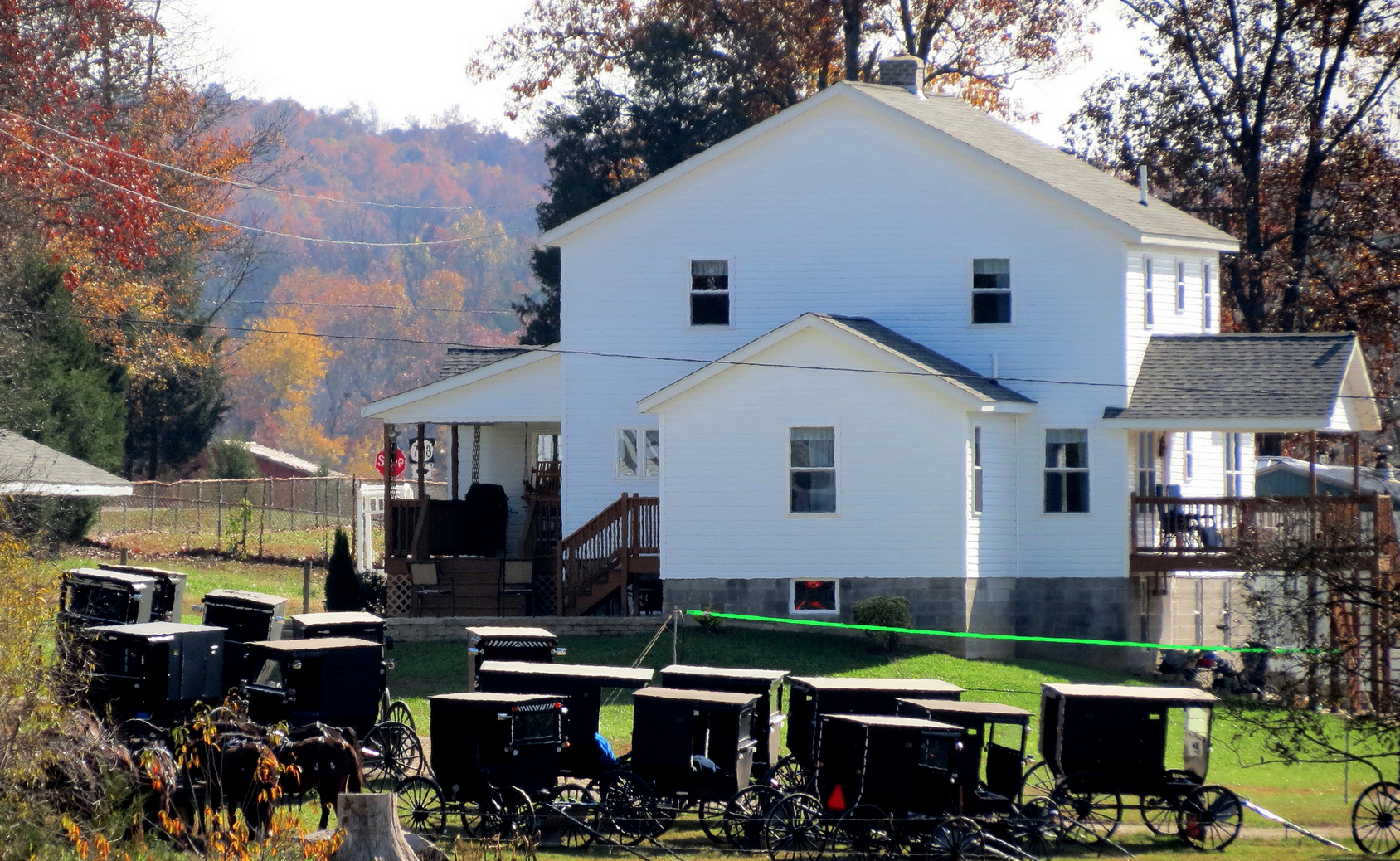
Everything You Want to Know About: Amish Church
What happens at an Amish church service?
It’s one of the most unique worship experiences in the U.S., shaped by centuries of tradition. In this article, guest writer Erik Wesner explains how the Amish worship, what they believe, and how their church communities are organized.
“The Amish are widely recognized as a devout people. God—and by extension the church—is the center of Amish life. Not just something they do on Sunday, the church is very much a part of everyday life.”
*This article was updated on 06/02/2025.
Read more of Erik’s explanation:
Table of Contents
Do the Amish Worship in Church Buildings?

First of all, it should be noted that the Amish church is unlike most other Christian denominations in that church is not held in a special building constructed for the purpose. Instead, Amish have church services at their homes—either within the home itself (in a large room or basement), or in another structure on the property, such as a workshop or barn. Benches are moved from one home to another via a large purpose-built wagon to accommodate worshipers.
Amish believe that the church is not the building, but the body of believers. They are also apt to see large structures like a church building as wasteful. Having church in the home emphasizes the believers as the essence of the church, but it also means the Amish do not incur the large costs of building and maintaining a special house of worship.
How Amish Churches Are Organized
Amish churches are organized into geographically-based districts, typically of 25-35 families. Since Amish practice home worship and also rely on horse-drawn travel, it’s necessary that all members can reach all other homes in the district within a reasonable amount of time. Thus church districts are typically comprised of the families within the immediate area.

A district is simply a group of homes whose members belong to a given congregation. A community may be comprised of a single district, or many districts lying adjacent to one another. When a church begins to exceed a certain size, preparations will begin to divide the church. This includes ordaining a new set of ministers to lead the new congregation.
Since Amish churches are small, families tend to get to know one another well (as they’re typically near neighbors—and often relatives, the bonds may be close in other ways). Church members are often involved in activities with other church members—for example, with the ladies getting together to quilt or do another productive activity, or men participating in work “frolics” to build a new structure for a fellow congregant or complete some other task.
Additionally, Amish believe strongly in the principle of mutual aid. When there is a material need in the community, church members will support one another financially and in other ways. This may be done by taking up a collection at service, or by holding a benefit auction or meal.
Who Leads an Amish Church?
A bishop, two or three ministers, and a deacon lead each church district. . The bishop is the head of the church and helps provide spiritual guidance to the congregation.
What Does the Bishop Do in an Amish Church?
Contrary to popular belief, the bishop doesn’t single-handedly decide the rules (known as Ordnung) of the church. His roles include ordaining ministers, bringing votes on issues such as technology or excommunication to the congregation, and performing marriages and baptisms.
What do Ministers and Deacons do in an Amish Church?
Ministers typically preach on Sundays, and may be joined by a visiting minister from another district. The deacon is in charge of alms collections and other “behind-the-scenes” tasks, including assisting the bishop in disciplinary issues.

How Are Church Leaders Chosen?
All church members (male and female) choose their leaders from among baptized males through a selection and nomination process. The nominated candidates then select a book from a group, one of which has been prepared with a piece of paper, typically with a Scripture verse (the man who selects this book is ordained).
Do Amish Church Leaders Get Paid?
Amish church leaders do not receive payment or formal training for their service, though they are typically highly respected in their communities.
When Do the Amish Go to Church?
Amish church service is held every other week (Amish go visiting, rest, and/or hold devotionals at home on the so-called “off” Sunday).
What is an Amish Church Service Like?
The service itself typically lasts three hours (in the plainest churches it can last four), and consists of singing, two sermons, and prayer. A members’ meeting may follow it when any outstanding issues might be discussed.
What Food is Served After Amish Church?
Church is always followed by a fellowship meal consisting of simple foods such as meats, cheeses, pickled vegetables, peanut butter spread, black coffee, and pie. There are typically between 100 and 150 people at a given church service.

In addition to church service, Amish also hold a number of other religious ceremonies, including baptisms (occurring twice per year in the spring and autumn), Communion (also twice per year), Council service (preceding Communion, a time of “purification” when the church readies itself for Communion), and marriages.
A Faith Lived Daily
The Amish believe in living their faith, and the church provides a structure and venue to do that, in close community with other like-minded believers. Amish tend to favor small-scale things, thus the limited numbers in each individual congregation (there are no Amish “mega-churches”). More than a building or just a venue for Sunday worship, the Amish church consists of a body of believers trying to imperfectly follow Christ in their everyday lives.
By Erik Wesner, author of Success Made Simple: An Inside Look at Why Amish Businesses Thrive, and editor of the Amish America website.
Learn More About the Amish
- Different Types of Amish
- Amish Beliefs
- Amish Clothing
- 6 Things You Might Not Know About the Amish and Money
- Amish Families
- Amish Businesses
- Amish History
- Amish Children
- Amish Misconceptions
- Pennsylvania Dutch – the Amish Language
- What the Amish Read
- The Amish and Technology
- Amish Wedding Traditions
- Places You Didn’t Expect to See Amish People
- Amish Games and Entertainment
Seth Carter has been with DutchCrafters since 2020. Seth has won multiple awards for his work in Amish furniture while with DutchCrafters. He has advised and partnered with more than 150 Amish wood shops on furniture presentation, design, industry trends, product options, and the development of exclusive products. He is originally from Indiana and even lived in Amish country (LaGrange, Indiana) for an extended period of time while working with DutchCrafters. Seth was previously in charge of DutchCrafters' Amish bedroom furniture category. He was eventually promoted to lead the team that managed every product in DutchCrafters' world's largest online collection of Amish furniture.

 Samples
Samples




Once again an excellent article. I read a lot of Amish based books and have been to one Amish singing years ago. Of course, I couldn’t sing the German but when they sang out of the “Christian Hymnal” I was able to sing because I knew those songs.
How interesting! An Amish singing is quite the experience.
I thought Amish were not allowed to use electric
tools~ there are 2 men (with logging horses) next to my house using chain saws after horses drag logs out ???? Isn’t this hypocritical?
Hi Kelly,
The use of power tools can vary, depending on the community.
Here’s a good link to a guest blog by Erik Wesner of http://www.amishamerica.com as well as a link to our podcast that covers misconceptions about the Amish. Hope these are helpful.
https://www.dutchcrafters.com/blog/everything-you-want-to-know-about-the-amish-and-technology/
https://www.dutchcrafters.com/video/video/misconceptions-about-amish-furniture/
Thank you for your question and for visiting Timber to Table.